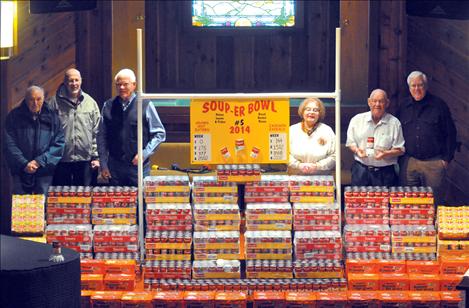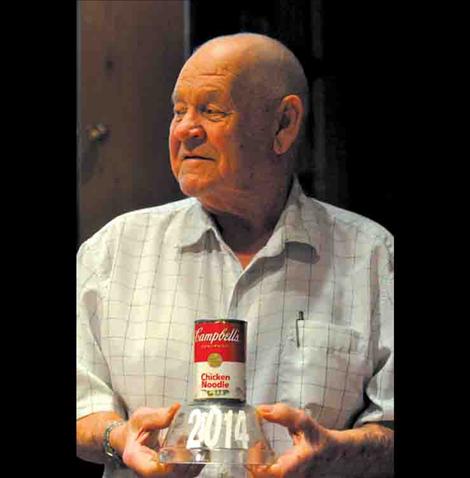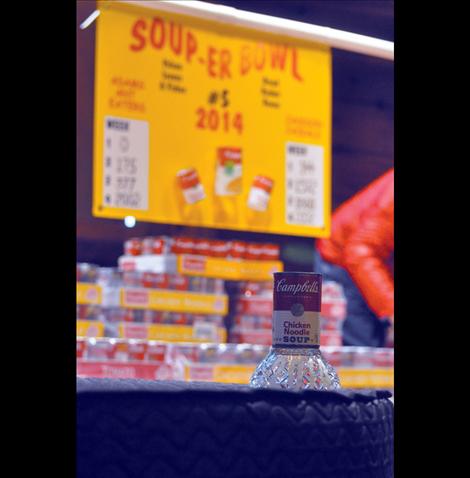Soup-er Bowl Challenge provides much needed food
Hey savvy news reader! Thanks for choosing local.
You are now reading
1 of 3 free articles.
While Americans watched an anti-climatic blowout that concluded the season of the nation’s favorite sport on Feb. 2, Ronan’s Seventh Day Adventist Church crossed their fingers in a nail-biting ending to a charitable event that parodies the sporting event and brings food to families who might otherwise go hungry.
The 5th annual Soup-er Bowl Challenge ended with 4,004 cans of soup collected and donated by the church’s parishioners to the Ronan Bread Basket and Polson Loaves and Fish. The number was more than double the number of cans collected last year, and 10 times as many cans collected the first year, said Russ Jenkins, community outreach coordinator for the church.
The church split into two teams during the month of January, the Jackson Jackals and Adams Anteaters. Each team collected 2,002 units of soup each.
“It was a dead tie,” Jenkins said.
Dale Jackson was captain of the Jackals, and attributed success of the drive to Jenkins’ enthusiasm, charitable church members, and the generosity of Walmart Supercenter in Polson. The store gave 3,200 units of Campbell’s chicken noodle soup to split between the teams.
“I didn’t have to do much,” Jackson said. “Russ just stands up and talks to people and things get done … And Walmart, they gave us the stuff for less than it cost them.”
Soup is especially helpful for families with children, Sherri McDonald of the Ronan Bread Basket said.
“Kids can make it by themselves if mom or dad isn’t home,” McDonald said.
Merle Parise and Bryan River of the Polson Loaves and Fishes food pantry said the donation of soup is appreciated because the supply of canned beans and soup from the Montana Food Bank Network has dried up in recent months.
“We’ve had to cut way back on cans of soup,” Parise said. “We’ve been forced to buy some of it. We used to give a family of four four cans. Now we only give them two.”
Each family will receive one more can becuase of the donation. The soup will likely last about three months, Parise said.
Brent Weisgram, chief operations manager of the Montana Food Bank Network said the pantries will likely see a shipment of soup soon. Last week the Montana Food Bank Network, which supplements almost 200 member pantries in the state, landed a shipment from Campbell’s. Each day the network and other major food banks across the country compete in a fierce battle for resources. Members of the national nonprofit Feeding America network are entered into a computer that uses a complex formula that includes poverty levels, populations, average income, unemployment numbers and other economic indicators to spit out a number of “shares” given to each bank. The “shares” are used to bid on shipments of food donated by some of America’s biggest retailers. The entire state of Montana is pitted against densely populated cities for the resources, including Chicago and Los Angeles, Weisgram said.
Once the Montana Food Bank Network lands a bid, it must pay for transportation of the food to Montana. A recent shipment based in Pennsylvania cost $4,000 to transport, but it was a sweet deal for the $38,000 in goods that fed hungry Montanans, Weisgram said. Although Montana produces tons of beef and wheat every year, most of the food has to be trucked in.
“One thing Montana doesn’t have is major food processing plants,” Weisgram said.
All of the food that comes through the state’s food bank network comes from major retailers. The group does not hold food drives in individual communities primarily because it doesn’t want to take food out of those communities that may need them, Weisgram said.
“People often ask me if they should give to their local food bank or our network,” Weisgram said. “I tell them both.”
The Montana Food Bank Network is a major player in supplementing community food banks, but it’s not the bread and butter of the organizations which run predominantly on donations. People can find out what is needed in their individual communities, like soup and beans, by staying in touch with the pantries.
McDonald is amazed by the generosity of people.
“We’re not a rich town, but people give,” McDonald said. “We’re eternally grateful to the Mission Valley when they contribute to help our needy families.”
In August, Polson Loaves and Fish had seen a 15 percent increase in numbers of people frequenting the food bank from the previous year. Ronan Bread Basket reported a similar increase, with an unexplained surge of single male patrons.
Lake County has the state’s fifth highest rate of food insecurity with 18 percent of adults and 30 percent of children not receiving enough nutrition, according to data released by the Montana Food Bank Network in 2013.
“Food insecurity is when someone doesn’t know where their next meal will come from,” explained Diane Mathews of the Montana Food Bank Network in a July 31 meeting with local organizations.
The numbers are expected to increase again. Congress cut the food stamp program, known as the SNAP program, by $8.6 billion dollars last week.
“We haven’t seen (more people) yet, but I’m sure we will,” McDonald said.


















